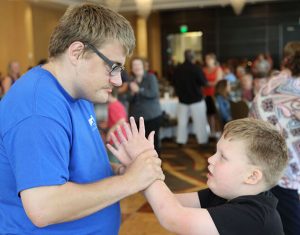Christine Brennan, MA, CCC-SLP/L, Member of PRISMS Professional Advisory Board
Reprint from PRISMS Spectrum Journal
School-based speech therapy services can address multiple speech, language, and communication needs in children with Smith-Magenis syndrome. School-based speech therapy can address communication issues that impact educational progress and overall functionality. It is important that parents, speech pathologists, and educational teams work together to identify clearly defined communication goals that are measurable, achievable, and can be incorporated into daily school routines. Also, as the needs of children with SMS can vary, awareness and use of multiple strategies can lead to improved development of communication abilities.
Four important issues related to addressing communication needs of school-age children with SMS are (1) writing measurable goals, (2) incorporating sign language into daily routines, (3) using alternative and augmentative communication (AAC), and (4) addressing communication needs of adolescents with SMS.
IEP goals selected for speech/communication should target abilities that will have the greatest impact on social, academic, and functional success. While it may seem critical to address every need and deficit, it is unfortunately not practical nor efficient.
Children with multiple needs in communication make optimal progress when only a few goals/objectives are addressed at a time. It is better to have 2-3 goals with 1-3 benchmarks or short-term objectives per goal. Having too many goals and objectives can result in diluted therapy and limited overall progress.
It is important that parents, speech pathologists, and educational teams work together to identify clearly defined communication goals that are measurable, achievable, and can be incorporated into daily school routines.
Long-term goals, such as improving receptive language abilities for academic and social activities, target broader aspects of communication. Short-term objectives are highly specific and measurable. An example of a well-written objective for receptive language is: Child will follow novel 2-step directions during group activities given visual picture cues and up to one reminder with 80% accuracy.
Well written objectives will state the exact communication behavior being targeted (“increase accuracy for following directions”, state the setting or activity (“during group activities”), state supports if needed (“given visual picture cues and up to one reminder”), and state the target accuracy (“80%”). An objective that includes these parameters will tell anyone reviewing the IEP, assessing progress, or implementing interventions, what the child is expected to do.
Selecting objectives should be based on the child’s needs regarding functionality and past progress. While articulation may be a need, for example, a child who can be understood but can not answer questions may benefit more from working on expressive language, than on articulation. Functional objectives can be formulated by identifying the aspects of communication that have the greatest impact on behavior, frustration, learning, and socialization at school, at home, and in the community.
One important goal for children with SMS is to increase success of receptive and expressive language. For many children with delayed but emerging language skills, use of sign language can enhance both expressive skills and receptive comprehension.
Receptively, use of sign can serve as visual cues that supplement verbal communication. Anytime multiple modalities are employed, the likelihood that messages will be understood increases. Typical children as young as one year of age can begin to discriminate sign when paired with verbal communication. Use of sign to support comprehension can also be used with children with SMS from infancy.
 Expressively, young children with SMS who also have deficits in speech production/ articulation may experience frustration when they are unable to make themselves understood. Teaching and reinforcing the use of verbal speech in addition to sign language can give these children multiple ways to communicate with others. One limitation of sign is that there may be people the child encounters who are unfamiliar with sign and can not benefit from the child’s use of that communication tool; however, there is no danger when using sign paired with verbal communication that this will prevent a child from learning to talk. Use of sign can only enhance communication and language development and will not cause a child to become non-verbal or reduce his/her verbal communication.
Expressively, young children with SMS who also have deficits in speech production/ articulation may experience frustration when they are unable to make themselves understood. Teaching and reinforcing the use of verbal speech in addition to sign language can give these children multiple ways to communicate with others. One limitation of sign is that there may be people the child encounters who are unfamiliar with sign and can not benefit from the child’s use of that communication tool; however, there is no danger when using sign paired with verbal communication that this will prevent a child from learning to talk. Use of sign can only enhance communication and language development and will not cause a child to become non-verbal or reduce his/her verbal communication.
Use of sign and/or AAC will result in improved communication, reduced frustration, increased vocabulary, better language skills and improved behavior.
When verbal communication and sign is still insufficient, an alternative/augmentative communication (AAC) system may be considered. Use of AAC at home and at school can include low or high-tech systems. AAC systems can vary in size, complexity, and cost. Low-tech systems are cheaper and more durable. High-tech systems are more expensive and generally, more prone to damage. Low-tech systems include sign, pictures, communication books, and Picture Exchange Communication. High tech systems include devices with recorded or synthesized voice output that generally hold more vocabulary. The more messages in a system, the more the user must understand how to use the device and remember the locations of the various messages. Some devices have computer-based software with dynamic LCD displays, while others have buttons that can play recorded messages.
Some companies that make and sell devices include: Dynavox (dynavoxtech.com), Prentke Romich Company (prentrom.com), Enabling Devices (enablingdevices.com/catalog), Ablenet (ablenetinc.com), Adaptivation (adaptivation.com), Adamlab (adamlab.com) AMDI (amdi.net), Attainment (attainmentcompany.com), Great Talking Box (greattalkingbox.com), and ZYGO (zygo-usa.com).
Selection of an appropriate communication system requires an evaluation of communication abilities and needs to include (1) what a child wants and needs to communicate, (2 ) how many messages a child can generate, (3) accuracy for identification within given fields of various sizes, (4) visual processing abilities, (5) visual memory, and (5) level of independence. The process of evaluating and selecting an appropriate AAC system can and should take several months and will mostly likely be continuously re-evaluated and updated, especially as the child’s communication needs change over time.
As the school-age child begins to reach adolescence demands and expectations will begin to shift from basic functional communication and focus more on increasing independent living skills, leisure skills, and vocational skills. Communication goals may include comprehension of directions for job-based activities and daily living tasks, communication with peers and less familiar adults (such as people encountered in work places), and appropriate and safe communication within the community. Communication skills for adolescents should help develop and sustain peer relationships and friendships. Communication skills including negotiation skills, initiation of appropriate communicative exchanges, self-monitoring during social encounters, predicting outcomes, and decision-making should also be addressed. Adolescents with SMS seek control and independence and are often motivated to earn opportunities to demonstrate their skills. Rewarding these interests with opportunities to practice and use appropriate communication strategies during vocational tasks may be an effective way to channel these interests; instead of trying to engage the adolescent in more controlled structured and adult-directed activities. While intervention planning is important, it is also important to remember that the best or worst written goals are unimportant when compared to the quality of educational and therapeutic intervention. When school teams (parents, therapists and educators) work together, listen, and collaborate, so our children will be in the best position to learn and make progress. While team members may disagree on aspects of a program or IEP, there is always a way to merge ideas and incorporate various concepts into one child’s educational program.
To optimize the educational process, focus on overall goals and objectives and work to incorporate the targeted behaviors into the daily routine. Practice, reinforcement, and redundancy will result in the greatest changes. Persistence and cooperation will ease and expedite the process.


